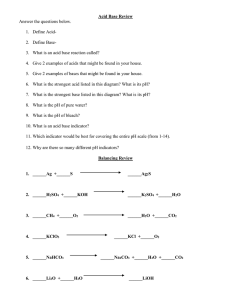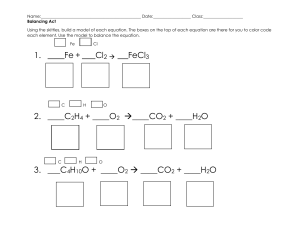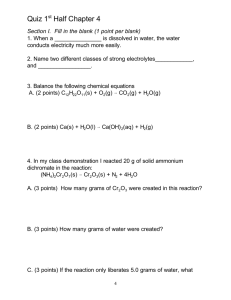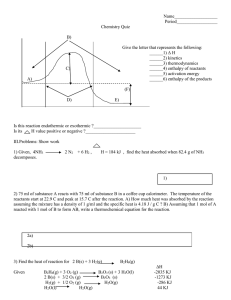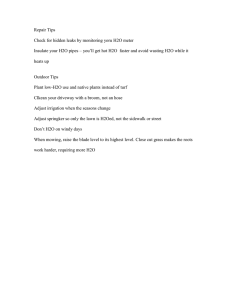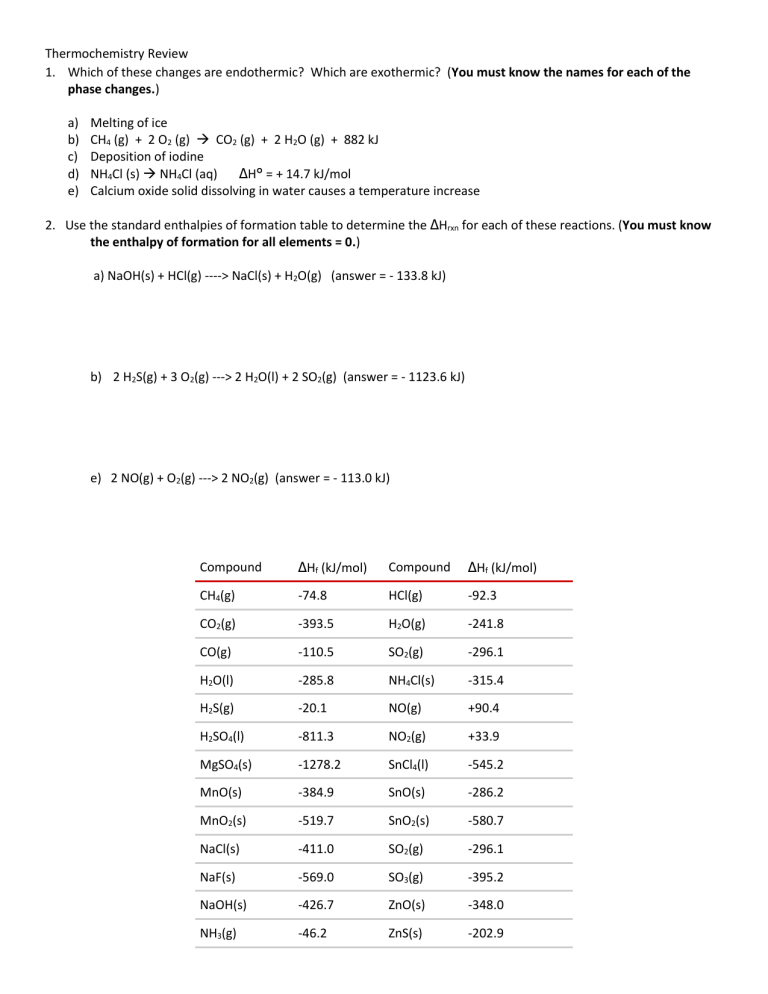
Thermochemistry Review 1. Which of these changes are endothermic? Which are exothermic? (You must know the names for each of the phase changes.) a) b) c) d) e) Melting of ice CH4 (g) + 2 O2 (g) CO2 (g) + 2 H2O (g) + 882 kJ Deposition of iodine NH4Cl (s) NH4Cl (aq) ΔH° = + 14.7 kJ/mol Calcium oxide solid dissolving in water causes a temperature increase 2. Use the standard enthalpies of formation table to determine the ΔHrxn for each of these reactions. (You must know the enthalpy of formation for all elements = 0.) a) NaOH(s) + HCl(g) ----> NaCl(s) + H2O(g) (answer = - 133.8 kJ) b) 2 H2S(g) + 3 O2(g) ---> 2 H2O(l) + 2 SO2(g) (answer = - 1123.6 kJ) e) 2 NO(g) + O2(g) ---> 2 NO2(g) (answer = - 113.0 kJ) Compound ΔHf (kJ/mol) Compound ΔHf (kJ/mol) CH4(g) -74.8 HCl(g) -92.3 CO2(g) -393.5 H2O(g) -241.8 CO(g) -110.5 SO2(g) -296.1 H2O(l) -285.8 NH4Cl(s) -315.4 H2S(g) -20.1 NO(g) +90.4 H2SO4(l) -811.3 NO2(g) +33.9 MgSO4(s) -1278.2 SnCl4(l) -545.2 MnO(s) -384.9 SnO(s) -286.2 MnO2(s) -519.7 SnO2(s) -580.7 NaCl(s) -411.0 SO2(g) -296.1 NaF(s) -569.0 SO3(g) -395.2 NaOH(s) -426.7 ZnO(s) -348.0 NH3(g) -46.2 ZnS(s) -202.9 REVIEW: So far you’ve learned about how to calculate: Heat associated with a phase change Heat associated with a temperature change Heat of reaction using standard heat of formation (ΔHf) Determine which method applies and calculate the enthalpy for each of the problems below. 2. For the reaction 2 C4H10(g) + 13 O2(g) 8 CO2 (g) + 10 H2O(l) the ΔH°comb is – 2877.4 kJ. a) What is the ΔHcomb° for the combustion of 1 mole of C4H10? (answer = - 1438.7 kJ) b) What is the ΔHcomb° for the production of 5 moles of H2O? (answer = - 1438.7 kJ) c) What is the ΔHrxn° for the production of 1 mole of C4H10? (answer = + 1438.7 kJ) 3. Calculate the mass of a sample of lead (CPb = 0.160 J/g.℃) when it loses 200. J cooling from 75.0℃ to 42.0℃. (answer = 37.9 g) 4. Calculate the energy required to take 450.0 g of water from 27.5°C to 102.0°C. (CH2O = 4.184 J/g°C, Csteam = 2.006 J/g, Hvap = 2260 J/g) (answer = 1.16 x 106 J) 5. A 28.4 g sample of aluminum is heated to 39.4 oC, and placed in a calorimeter containing 50.0 g of water. The temperature of water increases from 21.00 oC to 23.00 oC. What is the specific heat capacity, C, of aluminum? (for H2O(l), C = 4.184 J/g°C) (answer = 0.898 J/g.℃) 6. Calculate the heat of formation of ethane, C2H6 (g), if its heat of combustion, ΔH°comb, is - 3120. kJ as described by the equation is 2 C2H6 (g) + 7 O2 (g) 6 H2O (l) + 4 CO2 (g). (answer = 84.4 kJ/mol). The reference table you need is on the other side of this sheet.
